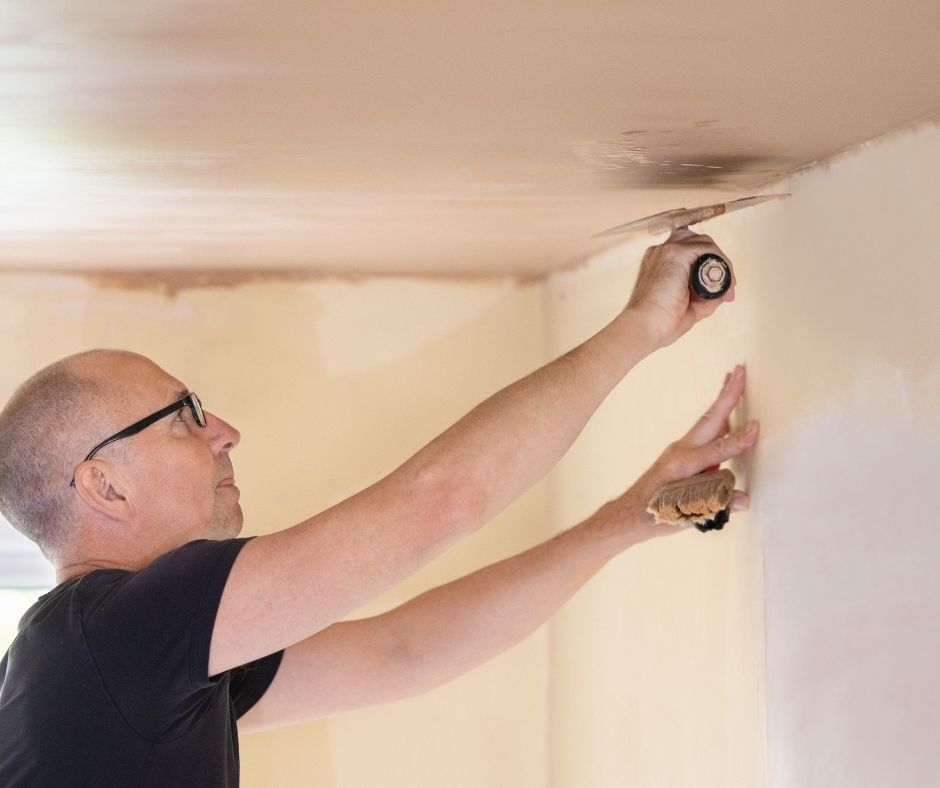Ceiling skimming is a smart solution when cracked, uneven, or textured ceilings spoil the look of an otherwise well-finished room — yet ceilings are often overlooked during home improvements.
Table of Contents
When we think about improving the appearance of a room, walls get most of the attention — but ceilings are just as important. A cracked, uneven, or dated ceiling can drag down the look of an otherwise pristine space. That’s where ceiling skimming comes in.
At P3 Plastering, we regularly help homeowners across South Yorkshire refresh tired ceilings with smooth, paint-ready finishes using the skim plaster method. This post explains exactly what ceiling skimming is, what to expect, and how much it typically costs.
What Is Ceiling Skimming?
Ceiling skimming is the process of applying a thin coat of finishing plaster (typically 2–3mm thick) to an internal ceiling to create a perfectly smooth, flat surface.
It’s done for two main reasons:
- To cover imperfections like cracks, tape lines, or uneven textures
- To create a clean, modern finish ready for paint or decorating
When Do You Need to Skim a Ceiling?
Here are the most common signs it’s time to consider a skim:
|
Sign |
Description |
|
Cracks or sagging |
May signal damaged plaster or movement in ceiling |
|
Old artex |
A skim coat smooths over textured ceilings (with preparation). If your ceiling has a textured Artex finish and it was applied before the year 2000, there’s a chance it may contain asbestos. However, if the surface is in good condition and not damaged, it can usually be skimmed over safely without disturbance. At P3 Plastering, we’re asbestos-awareness certified and follow official HSE guidance on working around asbestos, ensuring all work is carried out with care and compliance. |
|
Water damage stains |
Stained plaster can be sealed and skimmed for a fresh finish |
|
Poor previous work |
Patchy or DIY plaster jobs benefit from a pro-level skim |
|
Full refurbishments |
What’s Involved in the Ceiling Skimming Process?
Here’s how we carry out a standard ceiling skim:
Inspection & Preparation
- Check for blown plaster or water damage
- Apply bonding agents (e.g., PVA) for adhesion
- Protect all surfaces and floors below
First Coat Application
- Use trowel and hawk to apply the first coat of finishing plaster
- Smooth out quickly and evenly
Second Coat
- Applied while the first coat is still setting (wet-on-wet)
- Helps refine texture and build a uniform layer
Trowelling & Finishing
- Multiple trowel passes ensure a crisp, flawless surface
- Edges and corners feathered cleanly
Drying Time
- The ceiling is left to dry naturally (typically 3–5 days)
How Much Does Ceiling Skimming Cost?

Skimming prices depend on the size, height, prep needed, and access — but here are rough averages (2025):
Room Type | Approximate Cost (Ceiling) |
Small bedroom | £120–£180 |
Average lounge | £180–£300 |
Kitchen (incl. extractor masking) | £180–£250 |
Full 3-bed house (ceilings only) | £900–£1,500 |
💬 For an accurate quote, we always recommend an on-site visit — we’ll provide this free of charge with no pressure.
How Long Does It Take?
Ceiling Area | Time Estimate |
Small room ceiling | ½–1 day |
Large lounge | 1 full day |
Whole house | 3–5 days |
Drying times can vary depending on:
- Ventilation
- Room temperature
- Existing plaster condition
Skimming vs Reboarding a Ceiling
Sometimes, clients ask whether they should just remove the ceiling and replace the plasterboard instead.
Here’s a quick comparison:
Option | When to Choose |
Skimming | Surface is intact, just uneven or dated |
Reboarding | Ceiling is sagging, cracked badly, or structurally failing |
💬 We can help assess which is best during your quote visit.
Benefits of Skimmed Ceilings
- Smooth, modern look – no lines, dips, or patches
- Paint-ready – takes emulsion or mist coats well
- Improves lighting – flat ceilings reflect light more evenly
- Adds value – gives a fresh feel during home sale or let
- Compatible with downlights – easy to mark & install
Frequently Asked Questions About Ceiling Skimming
Can I skim a ceiling myself?
It’s possible but very difficult — ceilings are the hardest surface to plaster due to gravity and awkward angles.
How soon can I paint a skimmed ceiling?
Wait until the plaster turns from dark pink to light pink — usually 3–7 days. You should apply a mist coat of paint first to new plaster.
Can you skim over artex?
Yes, but we prep the artex thoroughly first to ensure safe adhesion and prevent cracking.
.
Why Choose P3 Plastering for Your Ceiling Skim?
With over 40 years of local experience, we’ve skimmed hundreds of ceilings in Sheffield, Rotherham, Doncaster and surrounding towns. Homeowners trust us for:
- ✅ Clean, tidy, respectful work
- ✅ Full insurance and qualifications
- ✅ Honest advice — no upselling
- ✅ Flexible timing, including weekends
📞 Ready for a Smoother Ceiling?
If your ceiling is cracked, uneven, or just looking tired, we can help. Whether it’s one room or the whole house, our team delivers flawless finishes and lasting results.
👉 Get a free quote or give us a call today — we’ll be happy to help.





